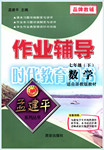题目内容
When Fei Junlong and Nie Haisheng stepped out of the hall, all the cameras were on them, flashing quickly.
A.pointed B.aimed C.focused D.directed
C
【解析】
试题分析:句意:当费俊龙和聂海胜走出大厅时,所有的相机都聚焦在两人身上,照相机飞快地闪光给他们拍照。A.pointed “指着”后面跟介词at或to; B.aimed “目标是” 后面跟介词at或不定式to do;C.focused“关注”后面加介词 on翻译为“聚焦” ;D.directed“指导”后面不加介词。根据翻译和固定搭配,故选C。
考点:考查动词辨析的用法。

练习册系列答案
 作业辅导系列答案
作业辅导系列答案
相关题目
最近,某英语报社就全球变暖这一话题向在校高中生征稿,请你根据以下表格信息,写一篇英语短文投稿。
现状 | 地球正在变暖 |
原因 | 二氧化碳的排放 |
森林减少 | |
大气污染、环境破坏 | |
应对措施 | 减少二氧化碳排放 |
种草种树、保护环境 | |
不使用一次性产品 |
写作要求:只能用5句话表达写作内容。
参考词汇:排放物 emissions 一次性的 disposable
